It is important to know how to develop logical framework for project proposal especially when dealing with projects. A logframe is a tool for planning and managing projects. It looks like a table and aims to present information about the basic logic of the project. Logframes were first developed by the U.S. military then later adopted by the US Aid as planning tools to help conceptualize projects and analyze the assumptions behind them.
They have since become an integral part of grant proposal for most donors. Apart from an obligatory document you need to prepare for the donor, the logframe is mostly a tool for you. With some basic questions it helps you define a project and map your plans. During implementation it can also help you to keep an overview and to spot issues before they arise.
How do you start developing the logframe? To develop a logframe you ideally start from a needs assessment. This can be one from your own organization, the donor or a partner organization. The result of the assessment gives you an idea of what needs to be achieved. The monitoring and evaluation team is the most essential team for you to work with while developing the logframe.
The Problem Tree Analysis
How to develop logical framework involves structuring your thoughts by working with a problem tree analysis. Write your key problem as the trunk of the tree, and then “branch off”. The needs analysis provides with an overview of the problem. To design your project, you need to turn this problem into something positive.
Example:
Problem – “Lack of School facilities” (can be the trunk of the tree)
One of the branch off (solution) could be “conflict-affected children have access to education in school with facilities ”.
Once you have done that and have several branch offs you will have an objective tree.
In this particular context you can answer the following questions to help you build your logframe:
- What is the project going to achieve? (Eg number of children accessing schools with facilities)
- What activities will be carried out? (Eg rehabilitating schools)
- What resources, people, equipment will you need? (Eg desks, construction materials, teachers)
- What potential problems might you come across? (Eg political stability)
- How will you measure the progress and ultimate success of the project? (Eg outcome survey)
Logframes are an important tool, but they are not set in stone. Context changes might rquire you to update them. This often needs to be approved by the donor first.
Logframe Structure
Most organizations and donors will have their own logframe template. You need to check with the specific donor, colleagues or your intranet before you start. Each template will more or less follow the same structure.
A standard logframe is a table with four columns and four rows:
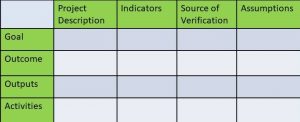
Goal
What does your project contribute to?
Example:
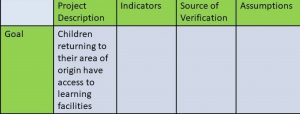
Outcome or Specific Objective
What will be achieved and who will benefit by the end of the project? Outcomes are the change that will result from your intervention which will help achieve the project goal. Look for actions such as increased, improved, etc.
Example:
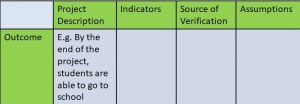
Outputs or Deliverables
Specific results of the project; these are products or services that the project delivers. Look for actions such as; delivered, proceeded, conducted.
Example:

Activities
What tasks need to be carried out to get the planned result?
Example:

Objectively verifiable Indicators – Measurement
Indicators seek to measure results, to provide evidence that results have been achieved or to provide a signal that progress is being made towards the achievement of results. They are means of measuring actual results against planned or expected results in terms of quality, quantity and timeliness. There should be a direct relationship between the Indicators and the result they are measuring. To ensure the validity of your findings always aim to have a balance between quantitative and qualitative indicators.
Example:

These should provide the proof you have done what you said you would do. They should not be vague but be specific in either qualitative (numerical values) or quantitative way (reflect perceptions, judgments or attitudes). You will need to report against all these indicators. Indicators should always be SMART: specific, measurable, achievable, relevant and time-bound.
Sources of Verification – Measurement
How you will collect information for the indicators. When writing a report, you will come back to these sources of verification to illustrate how the indicators were met. E.g. 75% of school-going children go to school.

Assumptions & Risks – Measurement
These are the external conditions needed to get results. There are two types of assumptions:
- The first refers to the design of your project: e.g. are there construction materials available?
- The second refers to environmental conditions: e.g. will the situation remain safe? Don’t go into too much detail here but stick to big impact.
Here is an example of what a row could look like completed
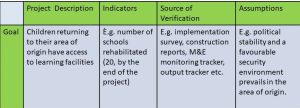
On average each project would have 4-5 mandatory output indicators and 1-2 outcome indicators.
How is the Theory of Change, Results Framework and Logframe Connected?
The Results Framework builds on the information found in the Theory of Change and the logframe builds on the information found in both the Theory of Change and the Results Framework. Find below how Theory of Change, Results Framework, and logframe align and connect.
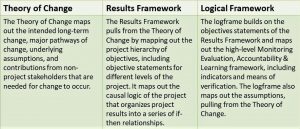
Conclusion
It is important to understand how to develop logical framework for the project proposal. A logical framework is used by different international organizations for the formulation of internal projects and proposal designs. It reduces planning confusion, increases the acceptability of the project, provides future guidance, and helps in achieving the goal of the project.

